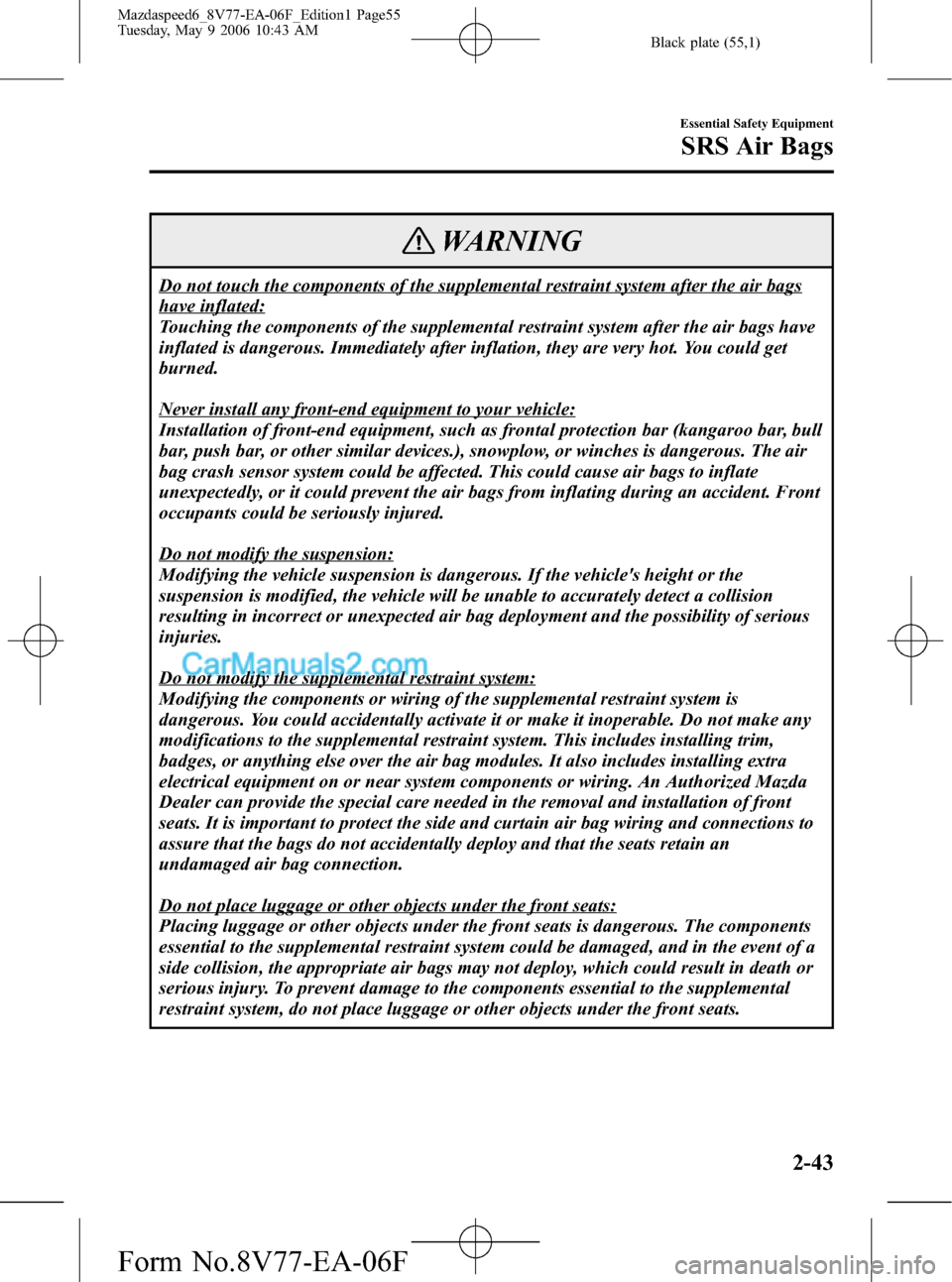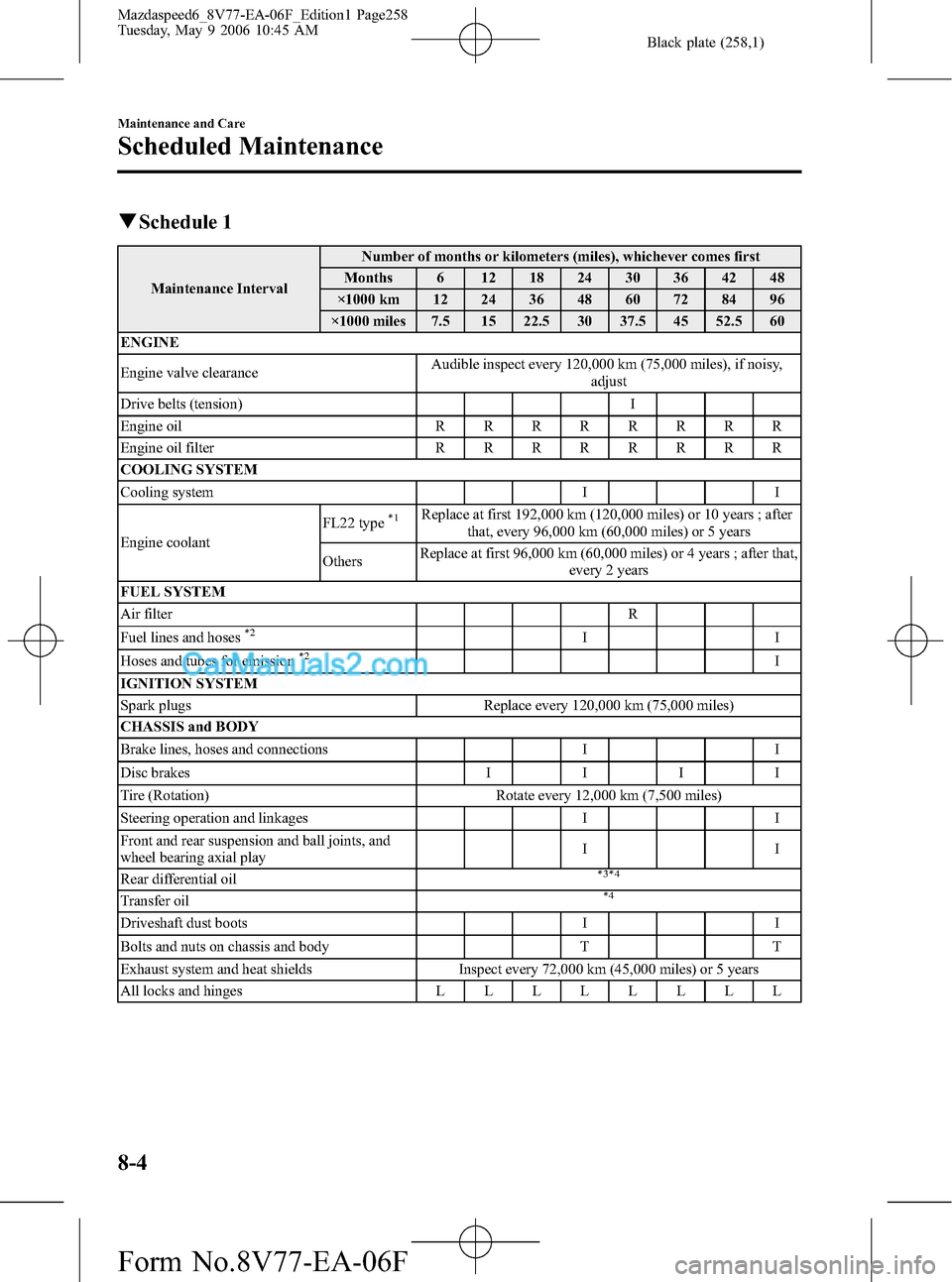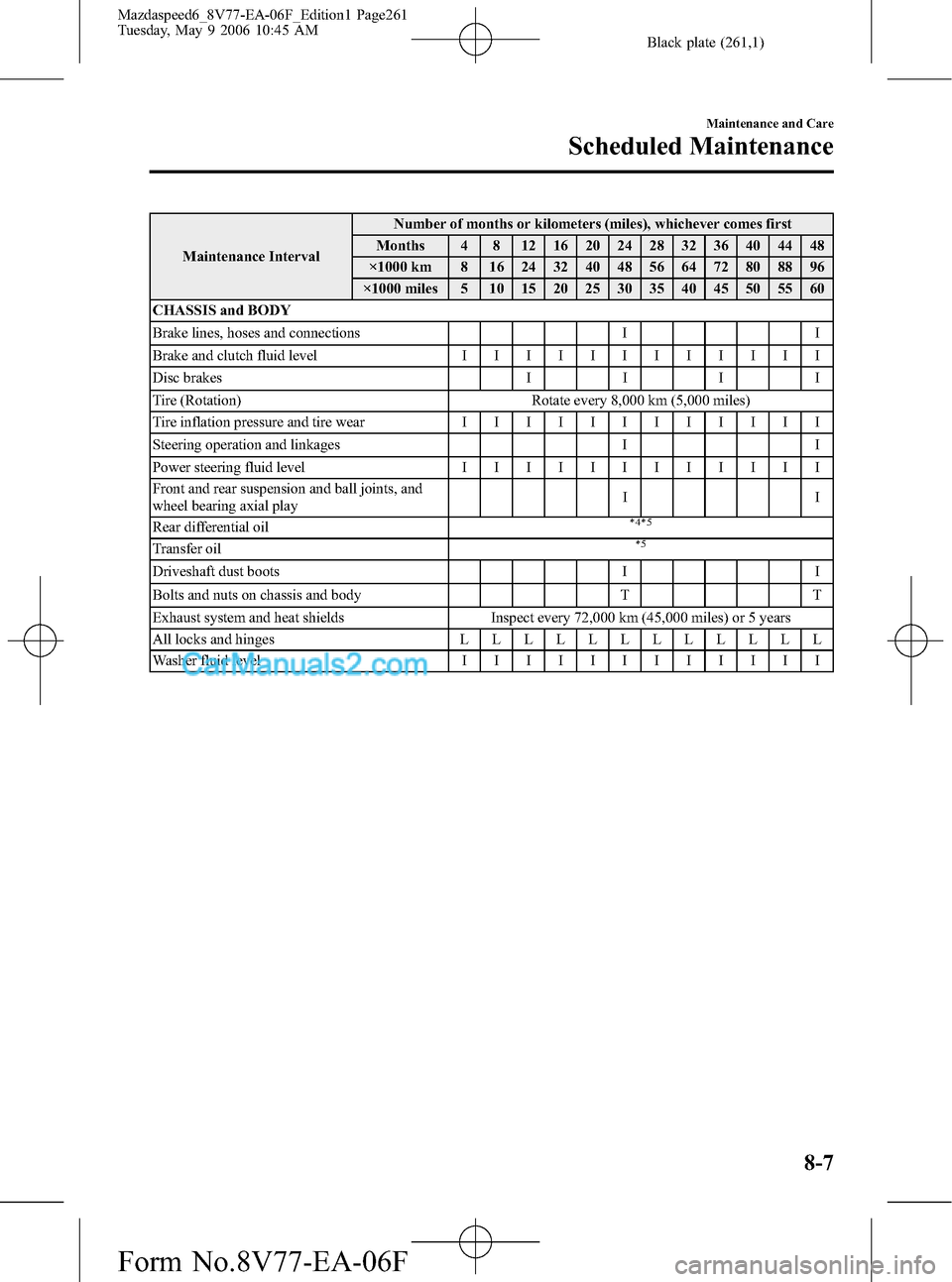suspension MAZDA MODEL MAZDASPEED 6 2007 Owners Manual (in English)
[x] Cancel search | Manufacturer: MAZDA, Model Year: 2007, Model line: MODEL MAZDASPEED 6, Model: MAZDA MODEL MAZDASPEED 6 2007Pages: 413, PDF Size: 10.97 MB
Page 56 of 413

Black plate (55,1)
WARNING
Do not touch the components of the supplemental restraint system after the air bags
have inflated:
Touching the components of the supplemental restraint system after the air bags have
inflated is dangerous. Immediately after inflation, they are very hot. You could get
burned.
Never install any front-end equipment to your vehicle:
Installation of front-end equipment, such as frontal protection bar (kangaroo bar, bull
bar, push bar, or other similar devices.), snowplow, or winches is dangerous. The air
bag crash sensor system could be affected. This could cause air bags to inflate
unexpectedly, or it could prevent the air bags from inflating during an accident. Front
occupants could be seriously injured.
Do not modify the suspension:
Modifying the vehicle suspension is dangerous. If the vehicle's height or the
suspension is modified, the vehicle will be unable to accurately detect a collision
resulting in incorrect or unexpected air bag deployment and the possibility of serious
injuries.
Do not modify the supplemental restraint system:
Modifying the components or wiring of the supplemental restraint system is
dangerous. You could accidentally activate it or make it inoperable. Do not make any
modifications to the supplemental restraint system. This includes installing trim,
badges, or anything else over the air bag modules. It also includes installing extra
electrical equipment on or near system components or wiring. An Authorized Mazda
Dealer can provide the special care needed in the removal and installation of front
seats. It is important to protect the side and curtain air bag wiring and connections to
assure that the bags do not accidentally deploy and that the seats retain an
undamaged air bag connection.
Do not place luggage or other objects under the front seats:
Placing luggage or other objects under the front seats is dangerous. The components
essential to the supplemental restraint system could be damaged, and in the event of a
side collision, the appropriate air bags may not deploy, which could result in death or
serious injury. To prevent damage to the components essential to the supplemental
restraint system, do not place luggage or other objects under the front seats.
Essential Safety Equipment
SRS Air Bags
2-43
Mazdaspeed6_8V77-EA-06F_Edition1 Page55
Tuesday, May 9 2006 10:43 AM
Form No.8V77-EA-06F
Page 259 of 413

Black plate (258,1)
qSchedule 1
Maintenance IntervalNumber of months or kilometers (miles), whichever comes first
Months 6 12 18 24 30 36 42 48
×1000 km 12 24 36 48 60 72 84 96
×1000 miles 7.5 15 22.5 30 37.5 45 52.5 60
ENGINE
Engine valve clearanceAudible inspect every 120,000 km (75,000 miles), if noisy,
adjust
Drive belts (tension) I
Engine oilRRRRRRRR
Engine oil filterRRRRRRRR
COOLING SYSTEM
Cooling system I I
Engine coolantFL22 type
*1Replace at first 192,000 km (120,000 miles) or 10 years ; after
that, every 96,000 km (60,000 miles) or 5 years
OthersReplace at first 96,000 km (60,000 miles) or 4 years ; after that,
every 2 years
FUEL SYSTEM
Air filter R
Fuel lines and hoses
*2II
Hoses and tubes for emission*2I
IGNITION SYSTEM
Spark plugs Replace every 120,000 km (75,000 miles)
CHASSIS and BODY
Brake lines, hoses and connections I I
Disc brakesIIII
Tire (Rotation) Rotate every 12,000 km (7,500 miles)
Steering operation and linkages I I
Front and rear suspension and ball joints, and
wheel bearing axial playII
Rear differential oil
*3*4
Transfer oil*4
Driveshaft dust boots I I
Bolts and nuts on chassis and body T T
Exhaust system and heat shields Inspect every 72,000 km (45,000 miles) or 5 years
All locks and hingesLLLLLLLL
8-4
Maintenance and Care
Scheduled Maintenance
Mazdaspeed6_8V77-EA-06F_Edition1 Page258
Tuesday, May 9 2006 10:45 AM
Form No.8V77-EA-06F
Page 262 of 413

Black plate (261,1)
Maintenance IntervalNumber of months or kilometers (miles), whichever comes first
Months 4 8 12 16 20 24 28 32 36 40 44 48
×1000 km 8 16 24 32 40 48 56 64 72 80 88 96
×1000 miles 5 10 15 20 25 30 35 40 45 50 55 60
CHASSIS and BODY
Brake lines, hoses and connections I I
Brake and clutch fluid levelIIIIIIIIIIII
Disc brakesIIII
Tire (Rotation) Rotate every 8,000 km (5,000 miles)
Tire inflation pressure and tire wearIIIIIIIIIIII
Steering operation and linkages I I
Power steering fluid levelIIIIIIIIIIII
Front and rear suspension and ball joints, and
wheel bearing axial playII
Rear differential oil
*4*5
Transfer oil*5
Driveshaft dust boots I I
Bolts and nuts on chassis and body T T
Exhaust system and heat shields Inspect every 72,000 km (45,000 miles) or 5 years
All locks and hingesLLLLLLLLLLLL
Washer fluid levelIIIIIIIIIIII
Maintenance and Care
Scheduled Maintenance
8-7
Mazdaspeed6_8V77-EA-06F_Edition1 Page261
Tuesday, May 9 2006 10:45 AM
Form No.8V77-EA-06F
Page 331 of 413

Black plate (330,1)
Vehicle Loading
WARNING
Do not taw a trailer with this vehicle:
Towing a trailer with this vehicle is dangerous because it has not been designed to tow
a trailer and doing so will affect the drive system which could result in vehicle
damage.
This section will guide you in the proper loading of your vehicle and/or trailer, to keep
your loaded vehicle weight within its design rating capability, with or without a trailer.
Properly loading your vehicle will provide maximum return of vehicle design performance.
Before loading your vehicle, familiarize yourself with the following terms for determining
your vehicle's weight ratings, with or without a trailer, from the vehicle's Safety
Certification Label and Tire and Load Information Label:
WARNING
Overloaded Vehicle:
Overloading a vehicle is dangerous. The results of overloading can have serious
consequences in terms of passenger safety. Too much weight on a vehicle's suspension
system can cause spring or shock absorber failure, brake failure, handling or steering
problems, irregular tire wear, tire failure or other damage.
Overloading makes a vehicle harder to drive and control. It also increases the distance
required for stopping. In cases of serious overloading, brakes can fail completely,
particularly on steep grades. The load a tire will carry safely is a combination of the
size of the tire, its load range, and corresponding inflation pressure.
Never overload the vehicle and always observe the vehicle's weight ratings from the
vehicle's Safety Certification and Tire and Load Information labels.
9-30
Customer Information and Reporting Safety Defects
Tire Information (U.S.A.)
Mazdaspeed6_8V77-EA-06F_Edition1 Page330
Tuesday, May 9 2006 10:46 AM
Form No.8V77-EA-06F